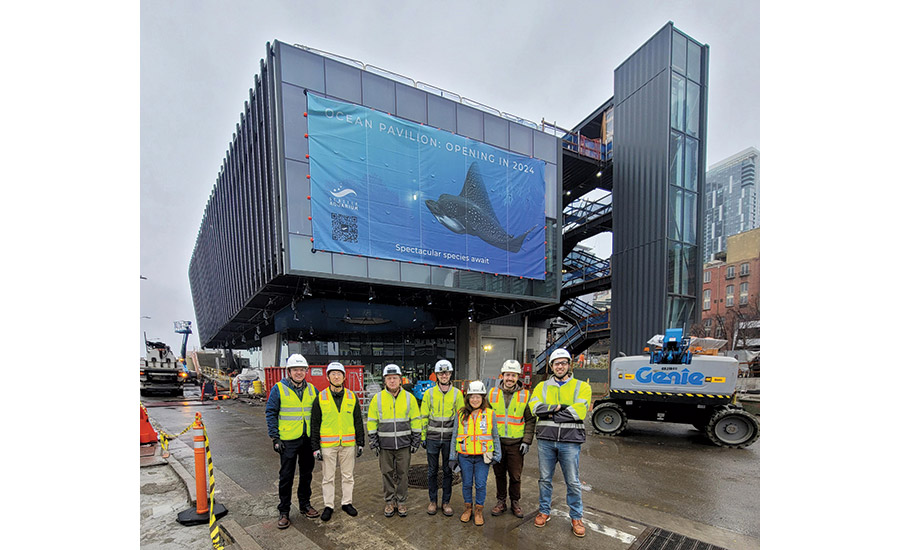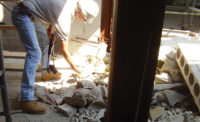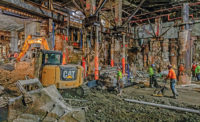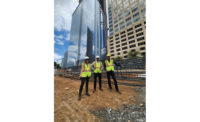
Related Article:
Seattle’s Audacious Aquarium Throws Builders Swerves, Curves, Twists and Turns
Back to:
25 Top Newsmakers
If not for the Great Recession and Sean Beatty, construction of the curvaceous reinforced concrete sea-creature tanks in the 50,000-sq-ft Seattle Aquarium Ocean Pavilion would have been even more arduous.
Without the 2007-9 recession, Beatty would not have been laid off from his job at a small architecture firm in Seattle. If not for that, he would not have gotten a second master’s, this time in construction management. And he would not have landed a job at Turner Construction Co., eventually joining the virtual design and construction department—where he became critical to the success of Turner’s audacious aquarium job.
Without Beatty inspiring his VDC team, Turner—which self-performed the back-breaking concrete work—might not have developed a detailed 3D digital concrete model for the tanks. The model was key, for it allowed the integration of the various incompatible 3D fabrication models from the different parties involved with the tank—work that was made even more complicated by a fill site along the waterfront in a high seismic zone.
“We engaged Sean [for the aquarium] during preconstruction because he was able to help the entire team,” including the client, LMN Architects and structural engineer Magnusson Klemencic Associates, “visualize how we were going to build this,” says Stuart Kibbee, Turner’s aquarium construction executive. “As the job progressed, Sean was able to think about how to use the model to build the darn thing.”
No simple exercise. The software providers for fabrication models of the different suppliers said their packages could not be integrated into Turner’s model, which was critical.
Beatty proved them wrong. “Under Sean’s leadership, Arash Naderpour worked to standardize and consolidate the formwork, rebar and MEP models from various programs into one space for a complete fabrication-level assembly,” says Kibbee. “In addition, Arash wrote code to both model the complex rebar and translate it into other programs,” he adds, which saved thousands of hours of rework.
Patrick Nation, operations manager for CMC Rebar, says CMC’s “monster job,” would not have been possible without Turner’s model, which showed every bar bent and positioned.
“It was really cool to see what Sean set up,” adds Aaron Dietzen, Trimble’s senior product content manager for the software SketchUp, which Turner uses. “Unlike most others in VDC, Sean knew what was going on in the project.”

Sean Beatty
Photo courtesy of Turner Construction
Beatty, VDC department manager since 2022, agrees the potential for error and rework would have been “huge,” without the detailed model, but he says he’s “just one cog in the wheel.” He calls the job “a massive team effort,” from the client to the workers, which goes way beyond himself and his own “great team” of 12 in Turner’s VDC group.
In high school in Fairfax, Va., Beatty says he focused on pottery more than on academics. But he knew he would study architecture. He went to Washington State University because he wanted to drive across the U.S., be far from home in a small college town and be able to snowboard. He earned his master’s in architecture in 2006 and worked until the recession hit. He received his master’s in construction management from the University of Washington in 2011. Turner hired him in 2011 on April Fools’ Day. In 2015, he joined its VDC group.
VDC work offers “creative opportunities,” says Beatty. “Our solutions help save money,” he adds.
The aquarium, nearing completion, is the “pinnacle,” says Beatty. Still, he is excited about the future, and especially artificial intelligence, which he calls intelligence augmentation.
“These digital tools are essential for how we become better builders,” he says.
All ENR 2023 Top 25 Newsmakers will be honored at the Award of Excellence Gala on April 11 in New York City.






Post a comment to this article
Report Abusive Comment